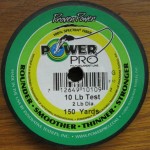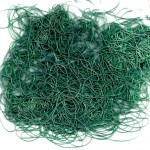Back to the future: A case for the new high tech low stretch fishing lines.
By Dr. Bogus
Remember the good old days with Dacron polyester by DuPont? “Better living through chemistry.” Right? Dacron kites, boat sails, rope and remember braided Dacron fishing line? Yes they still make braided Dacron fishing line and all the rest, but now the tackle shops’ shelves are filled with a host of high tech fibers that make up a contemporary list of no stretch or low stretch fishing lines. Exotic names like Spiderwire, Fireline, PowerPro and such. What do they do? Are they better than “mono”? Are they worth the added co$t? Good fishy questions.
All I have to say is, “try it, you’ll like it!!” So what DO they do? Fishing is a tactile sport. You cast, you feel, you jerk, you reel, you hopefully catch. Reacting appropriately to touchy, feely cues is an important part of successful fish catching. The more information (tactile input) you have the more fish you will catch. These low stretch lines in fact, are what they advertise. Did you ever feel a fish on the end of your line, and wonder just what he is doing? Ok, so with spot or blow toads or bluefish this is not so critical. They pull, you pull back and viola you have a fish, but how about that finicky pounder flounder or the subtle speckled trout.
Conventional monofilament is like a rubber band, your baited weighted line is stretched with your line in the water, and when you pull it stretches more before it responds with a hook set. It also stretches when the fish bites or strikes. Monofilament stretch can be as much as 25%, that’s 25-feet for each 100-feet of line. Low stretch lines, many of which are braided from gel-spun polyethylene strands, have virtually no line stretch when stressed. This means that you get what you feel and you feel it NOW. How would you like to feel the heartbeat of a Rat-L-Trap lure, a flounder scraping the scales off your captured finger mullet (it’s a myth though) or that mysterious nearly imperceptible bump of a citation speckled trout as he grasps your 17-MR MirrOlure, your Vudu Shrimp or Halo Shad. This is the information age you know. Braided and linear non-stretch lines can provide you with more information and more fish as well. You feel faster, you set the hook faster, you catch more fish. The other big plus is their strength. These lines are very thin, very strong and very tough high tech fibers. You often see designations of line strength, versus the strength of mono line of similar diameter. For example, the PowerPro braided line I’m currently using for my trout fishing is rated as 10/2. This is a 10 lb. test line with the diameter equivalent of 2 lb. test monofilament line. Very thin, very strong and very tough around abrasive structures.
Sensitivity is one advantage, but there are others too. With smaller diameter lines, you get more line capacity on your reel, you get better casting distance and if you are trolling there is less water resistance and therefore less weight to get your line to a bite zone. Since we are now officially in winter, braided lines have little or no line memory even on cold frosty mornings; the “slinky” coil effect (remember the slinky toy?) you get with mono lines is virtually nonexistent with the braided lines.
With all these positives, what are the downsides of braided line? Braids are slippery critters and you must be careful in tying knots. I always use a fluorocarbon leader tied directly to my braided line. Albright or reverse Albright will do the trick, many also use uni- to uni- knots for this function, I prefer a four-turn surgeon’s knot it’s quick and easy. Cutting and trimming the line is often difficult, although there are good tools to do this these days. Also, after I cut off the excess braid, I use a cigarette lighter or charcoal lighter to melt the end. It creates a bead and prevents the braid from fraying.
Another problem with the thinness of the line, which at times can slip through split rings, “eyes” on lures, snaps and other small gaps. The thinness of the line also can create a cutting hazard that will cut through fingers if you pull hard and cut through mono fishing lines as well.
 One of the main complaints you get from users and most “former” users is the so-called wind knots, especially with the lighter pound-test braided lines. These will create a tangle that is almost un fixable and may cost you $20 or more worth of line. That’s the bad news. The good news is that the so-called wind knots are actually the angler’s effort to blame Mother Nature for their own “operator error” and if you follow a few tips on the care and feeding and use of braided line, they can virtually be eliminated.
One of the main complaints you get from users and most “former” users is the so-called wind knots, especially with the lighter pound-test braided lines. These will create a tangle that is almost un fixable and may cost you $20 or more worth of line. That’s the bad news. The good news is that the so-called wind knots are actually the angler’s effort to blame Mother Nature for their own “operator error” and if you follow a few tips on the care and feeding and use of braided line, they can virtually be eliminated.
So here are some tips for braided line users for the elimination of the dreaded “wind knots”.
It’s never good to overfill your spools regardless of the line you use, and it’s even more important with braided line, so under fill your spool to minimize snarls from loose line/coils, this works for mono too.
Next, I always close the bail manually to minimize loose coils and manually tug on and place line in bail roller, then raise rod tip to tighten line and remove any loops. Look for loose coils that may have wrapped around the top of your spool. You can also and cast and rewind the line periodically through finger tips to tighten the line.
If (i.e. when) a loop gets caught under the line, do not open the bail and pull the line off of the top of the spool, and definitely don’t or cast it! Each time your line comes off the spool over a loop it wraps around the offending loop creating the so called wind knot. Instead, loosen the drag and pull the braided line through roller with the bail down, not flipped up.
If you forget to follow the above tips, or are a braid novice, remember, heavier pound-test braid, like 20-pound test will tangle less than lighter-pound test. If you follow the same tips for standard monofilament line as well, you also will eliminate most mono tangles not caused by line twist. I also use the Fuji guide design and micro guides on all my rods with braided line, which also helps minimize looping of the line around your rod guides.
Finally here are a few other tips for the braided line user. First, be careful to no overmatch your rod with a much higher strength line than it’s rated for, you may risk breaking your rod. Since there is little or no stretch, use gentler hook-set like a gentle sweep or wrist snap. Don’t try to set hook and land fish in one motion!! In the same vein, lighten up on the drag to compensate for the lack of stretch. Lastly, if you get hung-up on an obstruction, grab your reel spool and put pressure on the line from the spool to and pull straight back until you pull free or break off the line, NOT your rod, which you may break or worst, your hands where you risk a departed finger or minimally a nasty cut.
These suggestions should eliminate 95% of the knotting; the other 5% are usually caused by not following the above tips!
